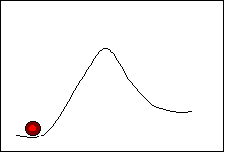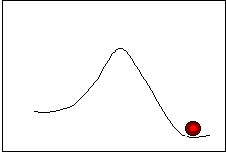system. change. transition state.
activation energy. zipper. dislocations.
Use Firefox browser or see essays-complete.pdf


Animation links refer to Web files. Click
on blue arrows or the word ANIMATE.
The question I am interested here is
how a system changes. I am coming back, therefore, to the
subject of Essay 23, On the Architecture of Change.
In Essay
24, On Myself, I was looking for a
place for myself in the Everything. I took notes of
addresses of some possible dwellings, taking complexity
as the avenue and size as the street, and making no
demands about the architecture.
I am going
to use the image of Sisyphus rolling his stone over the
hill, from Essay 23 , but without Sisyphus. The
stone alone will do. I only want to remind that in
chemistry change happens because the energy of molecules
spreads over a certain interval, so that the most
vigorous of them have enough energy to jump to the top
of the hill. Others take their place. The molecular
"stone" behaves more like a tennis ball.
Change in
society, as I see it, happens for the same reason with
mostly angry, agitated, and excited (or simply clever)
people instead of molecules or due to an individual
Sisyphus who manages to push the heavy stone over the
hill.
I will use
here some animations. They can be viewed by clicking on
the link ANIMATE or on a blue arrow.
The
BACK button of the browser will bring the
page back.
My first animated
illustration, Figure
25.51, shows change in a small simple
system. It has a small number of stable states
that looks like valleys between the hills, with the
height of the hill corresponding to the energy of the
transition barrier. The stone goes from valley to
valley in any order. All the valleys are about
equally deep and all the hills are equally high. We
should imagine the picture below as rolled into a
cylinder, so that the landscape is continuous and the
walk over the landscape is random.

I could make the illustration more realistic but I don't
think this would be worth rolling my stone uphill.
[FIRST FOUR
ANIMATIONS ARE DUPLICATED AT THE END OF THE PAGE]

ANIMATE  Figure
25.1
Figure
25.1
Figure 25.1 would be a
general case, but in highly ordered systems,
like the clockwork, the stone would simply go around in
the same sequence.

ANIMATE  Let it be
light!
Figure 25. 2
Let it be
light!
Figure 25. 2
Figure 25.2 should not be
turned into a cylinder because it evolves by rolling the
stone over a changing landscape. There is always a hill
ahead, there could be a retreat back, but the stone
steadily moves ahead, and the hill ahead is always new,
although it can be similar to some hill in the past.
A small
complex system, for example, a corporation, evolves in
time, but it can also jump between several
patterns of functioning, for example, recession, new
competitor, merger, spike in demand, major
lawsuit, etc. A large complex system, like nation,
goes through situations of revolt, crisis, war,
legislation shift, etc.
History of
France is a remarkable example of almost two century
long vacillation between authoritarian and republican
systems after the French Revolution, and history of
Russia presents a similar example of shifting back and
forth from liberalism to iron rule. On a much
smaller scale, America shifts between Republican and
Democrat governments, with the dynamism of evolution
overshadowing the differences.
The general
pattern of the terrain can go up or down, and it is an
intriguing question on what it depends.
 _Figure 25.3
_Figure 25.3
 _Figure 25.4
_Figure 25.4
_____________________
I believe it
depends on the production of energy (more accurately, free
energy, see Essay 7, On the Smell of Money
) , but I feel not fit to go into particulars of
non-equilibrium thermodynamics that are different from
those of the classic one.
If the energy of a system goes up, the system becomes less stable and more capable of jumping over the transition barrier. There are two possible situations in a transition: the other side of the hill can be either deeper than the initial one or it could be the opposite. A simple system with just one hill will spend more time in the deeper valley.
 The deeper valley is on the left.
The deeper valley is on the left.
ANIMATE Figure
25. 5
Figure
25. 5

The deeper valley is on the right.
ANIMATE  Figure 25. 6
Figure 25. 6
The problem is that in a large complex system we never know what is on the other side of the hill. The future is unpredictable. Human mind, however, can list most of the future alternatives as falling into past patterns. It is the pattern that connects the future with the past. Naturally, the future can present a new, never seen pattern.
Those are
two types of the roller coasters of change. Our clocks
are lucky to ride the circular type, but we, humans,
have all the fun of riding the roller coaster that we
can comprehend in its entirety only when we are almost
at the end.
One of the
possible historical ways to make a rising landscape less
steep is to decrease the buildup of energy by humans. It
can be done in at least two ways: by decreasing
population and/or by decreasing physical movement that
requires most physical energy. For example, as an
ultimate sci-fi picture, a planet can be populated by
something like motionless silicon devices feebly
exchanging light signals with each other through a fiber
network and producing a new device only when one of them
is damaged.
NOTE: More accurately, it is
appropriate to speak not about the buildup of energy
but about the distance from equilibrium. To
maintain a position far from equilibrium, which is
always inherently unstable, the system must consume
free energy and dissipate it into heat. When the
sources of mineral energy are exhausted, the general
intensity of human life can go down, closer to
equilibrium.
As
if
to foreshadow the possible future, we call each
other and send emails instead of meeting in person.
Computers consume very little energy. If terrorism or fuel
scarcity becomes part of life, people might travel less
and less and lose interest in each other.
There is
absolutely no reason to be fatalistic and pessimistic
because we can imagine only what belongs to known
patterns and can never imagine the radically new ones.
On the new and the different, see Essay 20, On
Artificial Art .
My final
question is how a large and complex system can change in
a radical way.
Any
imaginable small change has a certain probability. A
radical change of a big system consists of a large
number of small changes. Therefore, the probability of
such large change (more exactly, conditional
probability) directly depends on the products of many
fractional numbers, which is a very small number.
The reality
is that the small changes do not happen all at once. The
change of a large system happens locally and is spread
as a sequence of stages over time. I already mentioned
the theory of dislocations in Essay 22, On Errors
and the similarity of a large deformation to zipper.
My next
animated illustration shows the character of change in a
small system. It is difficult to separate two parts of a
large system with many internal bonds.
It is easy to
split the system through an ordered sequence of
small changes:

This is the
way zipper works. Each of many small consecutive stages
has a high probability and, more importantly, they are
lined up instead of branching out, as it is typical for
events in complex systems, for example, chemical
reactions, military battles, and historical
transformations.
The zipper
effect has extremely important implications in molecular
biology, but this is the knowledge outside our working
map here.
Small
systems are vulnerable because their zippers have a
small number of teeth and can be easily torn apart.
A big
problem arises: what is stronger in a direct clash:
fluid democracy or iron autocracy?
I think that
the outcome of a military confrontation depends on the
strength of the armies, and all the armies are supposed
to be iron autocracies.
In a non-military confrontation, I would not bet
on liberalism against a violent autocracy. But the
autocracy is incomparably more vulnerable than democracy
where liberalism is balanced by common sense. Democracy
heals its wounds, while autocracy has brittle senile
bones.
The
twentieth century brought to life a new kind of
organization: global network. We do not have enough
experience with them. The Communist network broke down
after the fall of the Soviet Empire. This may suggest
that cutting off the sources of energy and a blow on the
head would do the same to a terrorist network.
NOTE: On the story of zipper, see Henry Petroski, The Evolution of Useful Things: How Everyday Artifacts—from Forks and Pins to Paper Clips and Zippers—Came to Be . New York: Vintage Books, 1994.
P.S.
(2016)
“A
big
problem arises: what is stronger in a direct clash:
fluid democracy or iron autocracy?”
History
of
the twentieth century clearly showed that the
democracy-to-autocracy transformation can run much
easier that the reverse autocracy-to-democracy
restauration. The current century is producing no
rebuttal. By autocracy I mean not only the regimes of
Hitler, Stalin, and Putin, not to mention scores of
smaller figures, like Jacob Zuma, but even an election
of an autocratic leader, whether he or she is then
successful autocrat or not. It is not easy to kill
established democracy, but it is much easier to throw a
monkey wrench into its gears. From this point of view,
the American experiment in Elections 2016 is conclusive
already before the end of primaries and the national
vote: an autocratic, dishonest, and self-possessed
demagogue can go far when the angry (i.e., overheated),
unsophisticated, and uncritical electorate hears what it
wants to hear. This pattern is deeply rooted in human
nature. But
the same history shows that, in a direct clash,
autocracy is brittle and a few hits can break it,
probably, giving way to a new autocracy. See Essay 58, All
Rational Minds are Alike; each Irrational Mind is
Rational in its Own Way about human
irrationality. The supporters of Donald Trump are
rational in their own way: they do not have a simple reason
to distrust their idol until the future turns into the
present. Besides,
those who put Trump in the company of Hitler and Stalin,
have no reason, either. It is a pattern of belief as
surrogate knowledge that runs through millennia of
history and is as much a property of a naïve human mind
as desire for freedom and independence, wealth and
power, love and respect, truth and security. For more
about belief, see Essay 60, Art and
Nexistence.
The US Experiment 2016 has a new feature, however. None of the three major tyrants of the last hundred years came to power in an established democracy, all the more, as mature and lasting as US democracy. Therefore, there is a good chance that the minor strongman will fail.
NOTES:
1. On the story of zipper, see Henry Petroski, The Evolution of Useful Things: How Everyday Artifacts—from Forks and Pins to Paper Clips and Zippers—Came to Be . New York: Vintage Books, 1994.
2. Online animations of activation energy, i.e., the height of the transition barrier:
http://www.wbaileynet.com/wldchem/tutorial/rates/temp3.htm
http://www.wbaileynet.com/wldchem/tutorial/collide/temp2.htmbest
ANIMATIONS:




Page
created:
2001
Revised:
2016
Essays 1 to 56 : http://spirospero.net/essays-complete.pdf
Essays 57 to 60: http://spirospero.net/LAST_ESSAYS.pdf
Essay 60: http://spirospero.net/artandnexistence.pdf
 _____
_____
